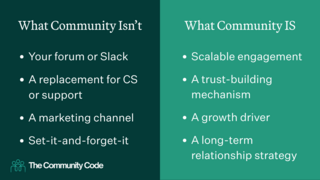Growth Insights| June 2025
How Growth-Stage Companies Can Leverage Community-Led Growth

Traditional GTM is a sprint: fast, transactional, and expensive. Community is a flywheel: slower to start, but once it’s in motion, it sustains itself and can drive efficient growth for most growth-stage companies.
Last month, we invited Josh Zerkel of The Community Code – who has a deep background in community-led growth and GTM strategy across companies like Asana, Evernote, and HeyGen – to unpack what “community-led growth” really means for Spectrum’s portfolio company marketing leaders.
“When done right, a community becomes a long-term, compounding GTM motion that builds trust, drives adoption, and fuels customer expansion,” says Zerkel. “But while I’ve seen firsthand how a community can move from the sidelines to become a central driver of revenue…I’ve also seen it go wrong when companies don’t put in the strategic hours upfront.”
As Zerkel defines it, community-led growth can support the customer journey at every stage:
- Acquisition: through peer-to-peer recommendations and user-generated content
- Adoption: through learning hubs, templates, and community-led onboarding
- Retention: through relationship-building, feedback loops, and a sense of belonging
- Expansion: through advocacy programs and embedded champions
“When you invest in a community, you’re investing in relationships at scale,” he notes. “And that investment compounds, just like product or brand.”
When You Should – or Shouldn’t – Launch a Community
“The old model of ‘go buy some Facebook or Google ads’ has gotten more expensive and less effective,” says Zerkel. As buyers recognize when they’re being marketed to, and instead look to their peers to inform decisions, you might find that your traditional acquisition costs go up – and the community-led flywheel starts to look exceptionally appealing.
To temper expectations and help leaders better anticipate the investment ahead, Zerkel often advises marketers on what a community is not:
- A community is not a Slack group or forum. “Often when I’m chatting with new leaders about community, they’ll say – ‘We’ll just put up a Slack group and see what happens,’” says Zerkel. “It’s exceptionally dangerous, because you’re relying on your customers to drive the conversation.”
While 64% of online community visitors report increased visits to community sites compared to previous years (source: Personify), simply having a forum or Slack channel doesn’t equate to a thriving community; your team needs a plan to actively manage and facilitate engagement.
- A community is not a replacement for CS or support functions. 59% of organizations utilize online communities to provide customer support (source: BloggingX), “But these communities should complement, not replace, dedicated support teams,” says Zerkel.

- A community is not just a content marketing channel or distribution method. 77% of companies believe online communities enhance brand exposure, awareness, and credibility (source: Mighty Networks).
However, leveraging communities solely as marketing channels can erode trust. Authentic engagement is key.
- A community is not set-it-and-forget-it. Communities require ongoing attention.“People have real lives and real jobs – they’ll come in and out, and that’s normal,” says Zerkel. “You have to take an active role in continually engaging and re-engaging people to get the outputs you want.”
So when are you ready to launch a community? To Zerkel, the answer isn’t about company size or industry – it’s about readiness. You’re ready for a community program when:
1. You’ve achieved product-market fit or have early champions.
2. You have a clear business problem that a community can solve.
3. Internal leadership is on board with a long-term community investment.
4. You can commit people, time, and resources.
“Before you start experimenting, think about the long-term relationships you want to build,” says Zerkel. “How will you foster conversations? What value do you want to create for participants? What do you want them to create for each other?”
Getting Started with Community-Led Growth
As Zerkel has found, you don’t need a massive audience or enormous team to build a great community. But you do need:
- A business problem to solve: Onboarding, adoption, retention, or expansion. Pick one to start.
- A small but passionate user base: Early champions who are eager to connect and share.
- Executive buy-in: Communities require long-term thinking and resourcing.
- One high-impact initiative: Don’t try to build “a community”— build a program. A user group. A knowledge-sharing hub. An event series. Just one thing tied to a clear business goal.
Step 1: Find your business-critical community moment.
“Start with a goal,” says Zerkel. ”What’s the one thing a community can solve better than traditional marketing or sales tactics?”
Another way to frame the question might be: Where can a community move the needle most? If it’s onboarding, you might try peer-to-peer learning forums and user-generated content for adoption. Expansion? Advocacy programs can generate internal growth and external referrals. Retention? Engaged user groups drive long-term value.
“Find the one thing, and then pick the community strategies and tactics that ladder up to that goal,” he says.
Step 2: Start small, but make it count.
“Don’t try to build everything at once,” says Zerkel. Start small, but make your first project high-impact. As we’ve discussed, companies must avoid the trap of “building a community” before defining its goal. “The more narrow your focus, the more likely you are to achieve the right result.”
Step 3: Resource it.
“You have to resource a community in the same way you need to resource any other strategy,” he says. “Community strategies need dedicated investment for success. You need people, technology, and alignment between teams.
- Team: Decide who should own the program – Marketing? CS? A dedicated team? Under the COO or Head of Business?
- Time: Communities require long-term strategy – expect 12-24 months to see full impact.
- Tech stack: Will you use a community platform? CRM integrations? How will members connect, communicate, and meet (on and offline)?
- Data: Ensure you have analytics or data science support so that you can report on community impact.
Step 4: Measure & iterate.
Align your community strategy’s KPIs to company goals – e.g. retention, product adoption, referrals. In the Asana example above, Zerkel’s team tied community to adoption, retention, and growth.
Final thoughts: A strategy, not a tactic
“If I could leave teams with only one takeaway, it would be that building a community will only be a strategic lever if you treat it as such,” says Zerkel. “A community strategy focuses on engaging the people most critical to your business – your customers – and works best when it’s aligned to your goals, and built with care."
The content on this site, including but not limited to blog posts, portfolio news, Spectrum news, and external coverage, is for informational purposes only and does not constitute investment advice. Use of any information presented is at your own risk. Spectrum Equity is not responsible for any content reposted above from any third party website, and has not verified the accuracy of any third party content contained above. Spectrum Equity makes no guarantees or other representations regarding any results that may be obtained from use of this content. Investment decisions should always be made in consultation with a financial advisor and based on individual research and due diligence. Past performance is not indicative of future results, and there is a possibility of loss in connection with an investment in any Spectrum Fund.
Inclusion in any third-party list, award, rating, ranking, or other recognition is not indicative of Spectrum Equity’s future performance and may not be representative of any investor’s experience. To the fullest extent permitted by law, Spectrum Equity disclaims all liability for any inaccuracies, omissions, or reliance on the information, analysis, or opinions presented.